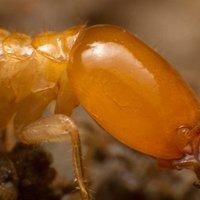Imagine a secret world beneath our feet where industrious insects create elaborate tunnels to find the ultimate treasure, wood. They will stop at nothing to find and voraciously eat that wood. Often, they will eat 24/7.
You and homeowners all over the U.S. just shuddered at the idea of a termite colony beneath your feet. That’s because subterranean termites cause over five billion dollars in structural damages each year. They are known as the “silent destroyers” because they soundlessly eat away at your home. Follow along, and learn about termite damage and how to protect your Connecticut home from a termite infestation.
These interesting insects are hard to spot with the naked eye at just 1/8-inch-long. Subterranean termites range in color from creamy white to brown or black. Termites possess saw-toothed jaws that enable them to eat mouthfuls of wood. They don’t work alone. Subterranean termites live and work in colonies. Each termite performs a specific job function. Colonies can have a staggering number of termites, sometimes reaching into the millions.
As spring approaches, termites send swarmers out in search of a good spot for food. The rest of the colony soon arrives, living underground or, in some instances, above ground in a moist, undisturbed area.
Termite Damage To Your Home
Subterranean termites often go unnoticed until serious structural damage has occurred. Homeowners will see signs of what looks like water damage on floors and ceilings or wood that swells or bubbles. The smell of mildew also might indicate a termite infestation.
The damage caused by termites can be catastrophic. They eat their way through beams, joists, and framing, and even plaster or drywall. If left to their own devices they can seriously compromise the structural integrity of your home. This leads to extensive and costly repairs.
Preventing Termite Infestations
Since termites can be such a resistant pest, the best way to approach pest control for termites is prevention. Big Blue Bug Solutions offers these suggestions for preventing termite infestations in your Connecticut home.
- Avoid standing water or excessive moisture around your home. Termites need water to digest cellulose. Properly draining water away from your home can lessen the value of your real estate to termite invaders. Fixing leaks and regularly maintaining clean gutters will eliminate a prime resource for termites.
- Don’t store woodpiles near your home. A woodpile, just like your home, is a smorgasbord for termites. It provides both food and water when the wood is saturated from the last rainfall. A woodpile may be outside your home, but it provides a gateway into your home for hungry termites.
- Eliminate entry points by sealing cracks and openings. Termites can’t eat their way through the concrete. But they can slip through cracks just a fraction of their body size. Homeowners can cut off their entry by sealing any cracks in or around concrete foundations. Fill holes made for running utilities with cement, caulk, or grout.
- Clear the area around your home from plants and shrubbery. Just like a tree branch acts as a highway to your attic for a squirrel, trees and shrubbery act like a highway to termites. Whenever possible, trim the foliage away from exterior walls to prevent it from touching your home.
- Address wood-to-soil contact. An easy way to put roadblocks in the way of a colony of termites is to avoid wood-to-soil contact around your home. This is the most frequent site of secret termite entry. Use metal or concrete to cover any exposed wood.
Contact Big Blue Bug Solutions
The best way to protect your property from subterranean termites is with professional assistance. For complete termite removal, contact Big Blue Bug Solutions for a free inspection today.

